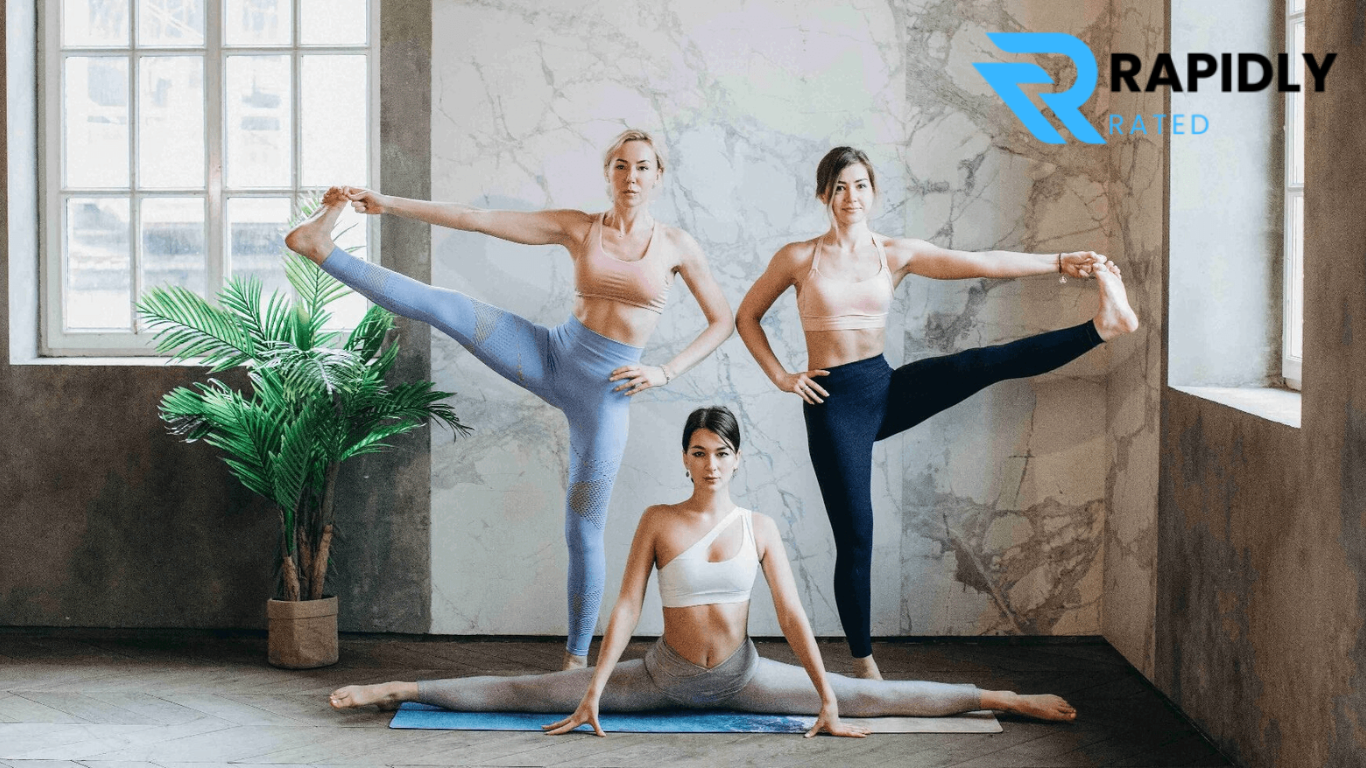In the practice of Yoga connection forms the cornerstone as you establish bonds with your physical body and breathing and others inhabiting your surroundings. Advancing to a duo-partner setup provides you entry to an alternative territory of quality time spent with partners through team tasks while delivering excitement.
Practicing trio yoga with three people creates an exceptional opportunity because it uses balance and strength alongside trust while allowing everyone to enhance personal fitness and strengthen friendships.
This guide will introduce you to trio yoga through instruction on both technique and select postures that lead to improved practice experience.
What Is Trio Yoga?
Three people engage in shared yoga poses through range-based postures which demand precise rhythmic motions together with partner assistance.
In contrast with individual purposeful yoga practice the focus on trio yoga shifts toward developing teamwork alongside enhanced communication among participants. This active practice blends contemplative practices with innovative yoga training by creating new perspectives on established yogic methods.
Benefits of Practicing Trio Yoga
Physical Benefits
- Builds Core Strength: When executing trio yoga poses individuals help each other maintain stability through supportive positions that activate their core muscles uniquely.
- Improves Flexibility: The unified stretching and joint motions help all practitioners develop better flexibility.
- Enhances Balance and Coordination: Trio yoga requires you to hone your body coordination while you practice synchronized motions with group members.
Mental and Emotional Perks
- Strengthens Bonds: Through trio yoga people develop deeper bonds of trust which shapes stronger connections between participants.
- Promotes Mindfulness: Balance requires our focused attention towards staying present to line up with our partners during interaction.
- Boosts Confidence: When your team performs intricate dance poses together you will experience a deep feeling of success.
Preparing for Trio Yoga

Essential Tips Before You Begin
- Choose the Right Space: Today’s options for practicing trio yoga include dedicated yoga studios and serene parks or any suitable space within your home environment.
- Dress for Success: Your workout outfit needs to be flexible and smooth because it needs to fit your body in every motion.
- Pick Suitable Partners: Choose partners for the team who know the level of skill you share and have an open mind to learn alongside you.
Warm-Up Together
The group needs warming up to relax muscles and establish synchronized energy levels. Try this quick sequence:
- Cat-Cow Pose: Joint your clients on hands and knees to move smoothly between cat and cow poses.
- Forward Fold: Keeping close formation extend your arms toward each other as a group so everybody holds this stretch for 10 to 15 seconds.
- Gentle Twists: During right-side twisting join hands with your partners for deeper stretch information.
Safety First
- Communicate clearly: Each exercise should be described due to ensure safety and comfort for the entire group.
- Use props: Yoga mats combined with cushions and straps serve to support practice and shield participants from harm.
Yoga Poses for 3 People: Step-by-Step Techniques
Beginner-Friendly Poses
1. Triple Forward Fold
How to Do It: Face each other as you execute this move keep the same orientation in a straight line. Everyone should move their body into a forward fold position while wrapping their hands around the arms or waist of the person just in front. Users must modify distances between bodies to achieve appropriate muscle stretching.
Benefits: Trust develops as you balance against each other in this stretching position which works on hamstrings.
2. Trio Downward Dog
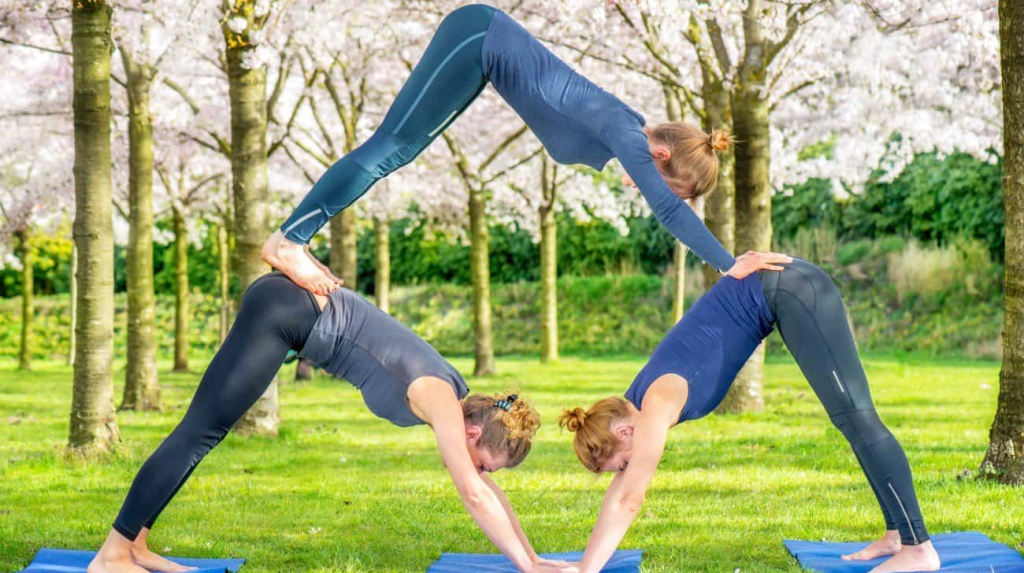
How to Do It: To initiate the pose the lead person adopts a regular downward dog position. In this modified downward dog position the second person’s legs gently rest on the first person’s back to form the double-decker effect. The third individual positions themselves on top of the second person’s back after they gain their position.
Benefits: You receive multiple beneficial effects from this pose which involves stronger arms and legs alongside better balance achievement and coordination enhancement.
Intermediate Poses
3. Flying Plank
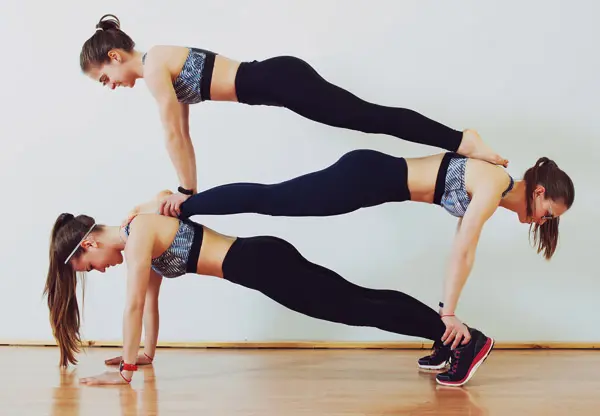
How to Do It: You receive multiple beneficial effects from this pose which involves stronger arms and legs alongside better balance achievement and coordination enhancement.
Benefits: Practicing this pose develops core strength while developing stability.
4. Three-Person Camel Pose
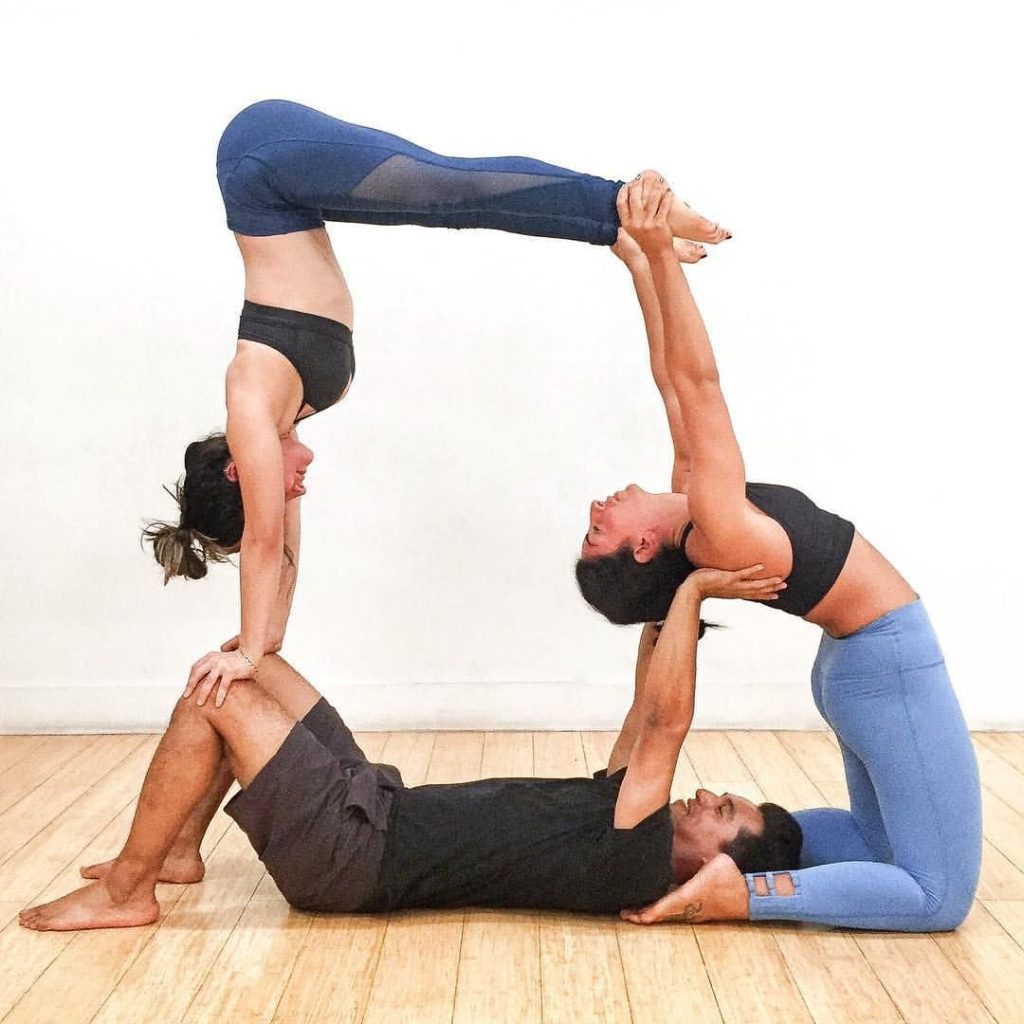
How to Do It: Participants should form a knee-connected circle. The poses with each person stretching into camel pose enables them to stabilize themselves using arm interlocks.
Benefits: This pose enables the chest opening while building back muscle strength together with teamwork dynamics.
Advanced Poses
5. Triple Tree Pose
How to Do It: Form a circle and maintain contact with each other while standing. Person after person maintains a single-legged stance then uses their lifted foot to rest against their thigh or calf.
Benefits: Core stability improves through this exercise because it strengthens the muscles while developing better focus.
6. Human Pyramid Pose
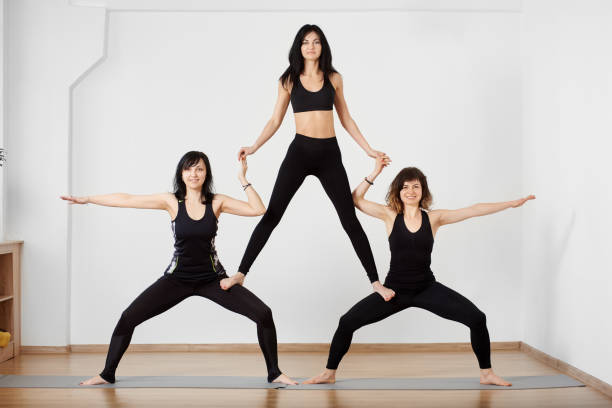
How to Do It: The base forming process starts when two individuals place their knees shoulder to shoulder for stability. To perform this pose each person must move to the top of the human tower while maintaining balance through their hands and knees.
Benefits: Balance and coordination face difficulties in this exercise as trust between participants develops.
Techniques for Better Synchronization
Breath Coordination
- Perform your breath and movements during yoga poses while working together to align actions.
- A numbered count should be used to ensure coordinated movements as demonstrated by saying “one-two-three lift” during transitions.
Clear Communication
- Each individual should take charge during poses or transitions while guiding the group for better understanding.
- Guide your teammates through movements using vocal directions which include “steady,” “shift weight” or “hold.”
Practice Patience
- Successful practice requires both slipping and stumbling since persistent attempts bring the most benefits. Laughing about mishaps makes the experience more entertaining so embrace your errors.
Common Challenges in Trio Yoga and How to Overcome Them
- Balancing Issues
- Solution: To prevent instability keep your core muscles active while maintaining equal weight distribution. Begin with basic postures that will increase stability to practice higher complexity poses.
- Miscommunication
- Solution: Set a plan before each pose. Leadership positions along with movement plans need selection before the practice begins.
- Fear of Falling
- Solution: Students should use soft mats during practice or choose to work out on grass areas. The practice requires mutual support along with avoidances of sharp physical activities.
Tips for Making Trio Yoga Fun and Engaging
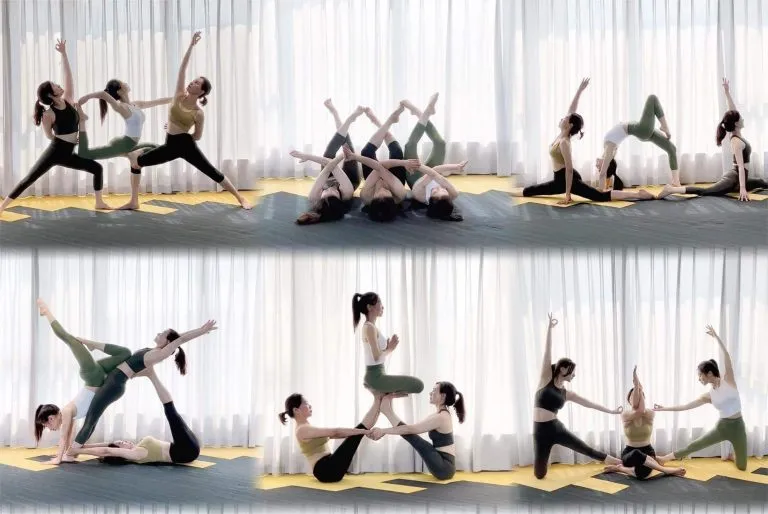
- Set Goals: Select challenging yoga poses which your team needs to practice.
- Celebrate Progress: To measure your pose growth you can film yourself executing different positions while sharing these recordings with others for laughter sessions.
- Experiment with Creativity: Create personalized style variations for your practice through the use of natural poses and animal-inspired transitions.
Trio Yoga Do’s and Don’ts
Do’s
- Proper warm-up prevents injuries so perform it first.
- The group should maintain enthusiastic support for one another as they engage in their session.
- After your practice finish with a relaxing savasana or perform a group meditation to help your body and mind relax.
Don’ts
- Don’t rush into advanced poses without mastering the basics.
- Avoid comparing ourselves to others; focus on teamwork and personal growth.
Cool-Down and Reflection
Cool-Down Sequence
- Group child’s pose: Sit back on your heels together and stretch forward.
- Reclined twist: Lie in a circle and twist gently to one side, resting on your neighbors for support.
- Savasana: Lie side by side, close your eyes, and focus on deep breathing.
Reflect Together
- Discuss how the session felt and share any highlights or funny moments. Celebrate your progress and set intentions for the next practice.
Conclusion: Why Trio Yoga Is Worth Trying
Trio yoga is more than just a workout; it’s a celebration of connection, trust, and creativity. Whether you’re practicing with friends, family, or fellow yogis, the experience is sure to be filled with laughter, learning, and growth.
So, roll out those mats, grab two partners, and embrace the joy and challenge of trio yoga. Your journey of balance, strength, and teamwork awaits!
Frequently Asked Questions (FAQs)
1. Can beginners try trio yoga?
Absolutely! Start with simple poses and work your way up.
2. What do I need to do to start trio yoga?
Just a yoga mat, comfy clothes, and two willing partners.
3. What if someone in the group loses balance?
Stay calm, regroup, and try again. Falling is part of learning.
4. How can we improve communication during poses?
Talk before each pose and use clear, simple cues while practicing.
5. Is trio yoga a good workout?
Yes! It’s a full-body workout that also improves flexibility and teamwork.

